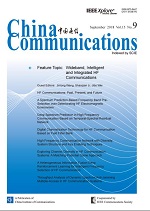COMMUNICATIONS THEORIES & SYSTEMS
Jia Wang, Ahmed Al-Kinani, Wensheng Zhang, Cheng-Xiang Wang, Li Zhou
2018, 15(9): 95-105.
In underground mines, visible light communication (VLC) system is a promising method to realize effective communication, which supports communication and illumination at the same time. Therefore, adequate research of underlying physical propagation phenomenon should be carried out to realize VLC system in underground mines. To design VLC system and evaluate its performance, accurate and efficient channel models, including large-scale fading and scattering characteristics, are needed to be established. However, the characteristics of the underlying VLC channels about fading and scattering have not been sufficiently investigated yet. In this paper, a path loss channel model, based on the recursive model, is proposed precisely. Its path loss exponent is determined by three different trajectories, which is studied in the mining roadway and working face environment. Besides, the shadowing effect for VLC has been modelled by a Bimodal Gaussian distribution in underground mines. Considering the number of transmitters in line-of-sight (LoS) as well as non-line-of-sight (NLoS) scenarios, our simulation illustrates the fact that, as the curve fitting technique is employed, the path loss displays a linear behavior in log-domain. The path loss expression is derived, it is related to the distance. Finally, root mean square (RMS) delay spread and Mie scattering in underground mines are analyzed.
